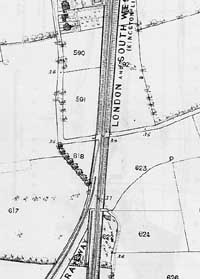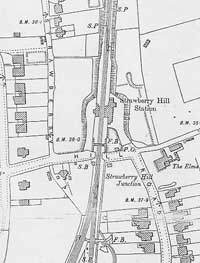Strawberry Hill Station
Why was it built?
1873


A glance at the Ordnance Survey Map for 1862 shows at once the absence of any station at Strawberry Hill and, of course, passengers from Shepperton journeyed through the junction with the Kingston Bridge Line and alighted at Twickenham Station. On the similar sheet for the 1898 survey the station at Strawberry Hill is clearly shown as are numerous houses and newly constructed residential roads. In fact the station was built and opened in 1873 and became the subject of numerous articles in the local press including the newly founded Richmond and Twickenham Times.
The intriguing question is why it wasn't thought necessary to build a station from the beginning of the railway? Unfortunately, it will probably never be possible for an authoritative answer to be given for the one certain source of information ~ the Directors' Minutes of the London and South Western Railway for the relevant decade ~ was destroyed during the 1940 blitz on London by a fire at Waterloo station.
There are two explanations which have been proposed over a number of years and, while they each have their own supporters, they are not necessarily exclusive of each other. One, is that the station was built at the behest of Lady Frances Waldegrave to ease the travelling for the many house guests she entertained at Strawberry Hill.

A more likely explanation of the chief reason for the opening of the station is that pressure was exerted on the railway directors by property speculators amongst whom was the Rt. Hon. Chichester Fortescue, fourth husband of Frances Waldegrave. Again there is no direct evidence but, in the absence of the critical railway records, an intelligent guess can be made from other sources, particularly the files of the local newspapers. Fortescue was one of the property developers as can be seen from the rows of Victorian villas surrounding the Waldegrave estate and clearly it would be easier to sell the properties with the added convenience of a nearby station with good links to London.
K.C. Breen, February 2003.
Further reading:
K C Breen, A Centenary, 1973, unpublished History of the Station, 1973, revised November 2002
Anthony Beckles Willson, Strawberry Hill - a History of the Neighbourhood, Strawberry Hill Residents Association, 1991 (2nd edition, revised, 1995)




